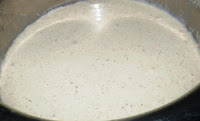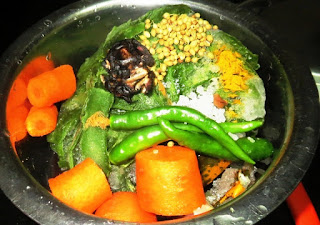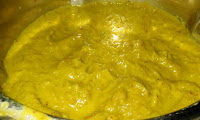Brinjal/Egg plant/Badane Kai/ Kattarikai Fry is a dry curry. Brinjal/Egg plant is liked by many people. Brinjal/Egg plant is always available in the market. You get different varieties of Brinjals.
I have just tried this brinjal and capsicum dry curry. It is one of the good combination and capsicum goes well with Egg plant. I have used home made spices, and the curry turned as spicy and yummy. I do use brinjal very often because it is one of my favourite veggie. You can cook many types of dishes like, Sambar, Huli (with coconut) gravy, dry curry, gojju, baratha, Vanghi baat, brinjal bath etc etc etc. So the lists goes up. Of course the dish is with different varieties of brinjal.
One has to be very choosy whie buying brinjals. I say this because even if there is a dot on the brinjal, there might be worm inside. Fresh brinjals taste better and cooks quickly. It it is few days old, it might not cook and the dish do not taste good.
I have used sesame seeds, it adds to the taste and gives good aroma to the curry. Sesame seeds are good for health too.
Let us see some benefits of eating sesame seeds/ellu/til in our diet.
Sesame seeds contain many health benefits. They are loaded with nutrients, minerals, antioxidants and vitamins. The seeds are rich in mono unsaturated fatty acids, They help to lower bad cholesterol and increases good cholesterol in the blood. They are rich with dietary protein and good amount of amino acids. Amino acids are essential for growth, mainly children. They are rich source of B complex vitamin, minerals like calcium, iron, manganese, zinc, magnesium. These minerals helps the bones strong, red blood cell production, enzyme synthesis and hormone production.
As I said Brinjal-Capsicum fry is an easy and yummy dish, goes well with chapatis, rotis, poori and even plain rice.
Capsicum : 1 to 2
Chutney Powder : 1 Tablespoon
Puliyogre gojju : 1 Teaspoon
Sesame seeds : 2 Tablespoons
Methi/Fenugreek seeds : 1/4 Teaspoon
Coconut : 2 Tablespoons (1/4 cup)
Salt : to taste
Ingh : a pinch
Oil : 2 Tablespoons
Jeera : 1/2 Teaspoons
Mustard seeds : 1/2 Teaspoons
Curry Leaves: 5 to 6
Coriander Leaves : 2 Tablespoons.
2. Wash and cut coriander leaves, capsicum and curry leaves.
3. Keep a pan and dry roast methi seeds and sesame seeds til sesame pops up. Leave it for cooling.
4. Grate or cut coconut and keep it aside.
5. Now dry grind grated coconut, roasted sesame-methi and chutney pudi. Remove powdered mixture to a clean plate or bowl.
6. Keep a pan on the fire and heat. Add oil and mustard seeds. Let it splutter.
7. Add jeera and fry for 5 seconds. Add, ingh, cut capsicum, curry leaves and fry till they turn soft.
Add cut brinjal and fry nicely. (At least 2 minutes). Now add puliyogre gojju (tamarind ) , salt and turmeric powder.
8. Mix it nicely and Let it be on low flame. Stir in between so that it does not burnt.
9. Add dry ground mixture and mix it nicely. Let it cook for 2 to 3 minutes. Mix it in between.
10. Now mix it again and add cut coriander leaves. Shift the dry brinjal -capsicum curry to a serving
bowl. Now Brinjal - Capsicum dry curry is ready to serve.
Use of any brand chutney powder will serve the purpose. Do not add water. It may over cook and turn the brinjal into soft. Using jaggery is optional.( I did not add).
Adding garam masla /amchur powder (dry mango powder) or lemon is optional(lemon instead of tamarind pulp). Garam Masala gives a different taste. Adding more/less oil is optional.
Time : 20 Minutes.
Serves : 3.
I have just tried this brinjal and capsicum dry curry. It is one of the good combination and capsicum goes well with Egg plant. I have used home made spices, and the curry turned as spicy and yummy. I do use brinjal very often because it is one of my favourite veggie. You can cook many types of dishes like, Sambar, Huli (with coconut) gravy, dry curry, gojju, baratha, Vanghi baat, brinjal bath etc etc etc. So the lists goes up. Of course the dish is with different varieties of brinjal.
One has to be very choosy whie buying brinjals. I say this because even if there is a dot on the brinjal, there might be worm inside. Fresh brinjals taste better and cooks quickly. It it is few days old, it might not cook and the dish do not taste good.
I have used sesame seeds, it adds to the taste and gives good aroma to the curry. Sesame seeds are good for health too.
Let us see some benefits of eating sesame seeds/ellu/til in our diet.
Sesame seeds contain many health benefits. They are loaded with nutrients, minerals, antioxidants and vitamins. The seeds are rich in mono unsaturated fatty acids, They help to lower bad cholesterol and increases good cholesterol in the blood. They are rich with dietary protein and good amount of amino acids. Amino acids are essential for growth, mainly children. They are rich source of B complex vitamin, minerals like calcium, iron, manganese, zinc, magnesium. These minerals helps the bones strong, red blood cell production, enzyme synthesis and hormone production.
As I said Brinjal-Capsicum fry is an easy and yummy dish, goes well with chapatis, rotis, poori and even plain rice.
Lets see the recipe now:
Things needed :
Brinjal : 5 to 6Capsicum : 1 to 2
Chutney Powder : 1 Tablespoon
Puliyogre gojju : 1 Teaspoon
Sesame seeds : 2 Tablespoons
Methi/Fenugreek seeds : 1/4 Teaspoon
Coconut : 2 Tablespoons (1/4 cup)
Salt : to taste
Ingh : a pinch
Oil : 2 Tablespoons
Jeera : 1/2 Teaspoons
Mustard seeds : 1/2 Teaspoons
Curry Leaves: 5 to 6
Coriander Leaves : 2 Tablespoons.
Method :
1. Wash and cut brinjal and put it in a big bowl of water. Let it soak at least 5 minutes.2. Wash and cut coriander leaves, capsicum and curry leaves.
3. Keep a pan and dry roast methi seeds and sesame seeds til sesame pops up. Leave it for cooling.
4. Grate or cut coconut and keep it aside.
5. Now dry grind grated coconut, roasted sesame-methi and chutney pudi. Remove powdered mixture to a clean plate or bowl.
6. Keep a pan on the fire and heat. Add oil and mustard seeds. Let it splutter.
7. Add jeera and fry for 5 seconds. Add, ingh, cut capsicum, curry leaves and fry till they turn soft.
Add cut brinjal and fry nicely. (At least 2 minutes). Now add puliyogre gojju (tamarind ) , salt and turmeric powder.
8. Mix it nicely and Let it be on low flame. Stir in between so that it does not burnt.
9. Add dry ground mixture and mix it nicely. Let it cook for 2 to 3 minutes. Mix it in between.
10. Now mix it again and add cut coriander leaves. Shift the dry brinjal -capsicum curry to a serving
bowl. Now Brinjal - Capsicum dry curry is ready to serve.
Note :
I have used home made chutney powder. Just roast, channa dal, urid dal, (equal portion) red chilly (byadgi chilly), ingh (a pinch), handful of curry leaves. Add a marble size of tamarind (remove the seeds from tamarind). Dry roast all these one by one. Dry grind when it is cooled.Use of any brand chutney powder will serve the purpose. Do not add water. It may over cook and turn the brinjal into soft. Using jaggery is optional.( I did not add).
Adding garam masla /amchur powder (dry mango powder) or lemon is optional(lemon instead of tamarind pulp). Garam Masala gives a different taste. Adding more/less oil is optional.
Time : 20 Minutes.
Serves : 3.






















































